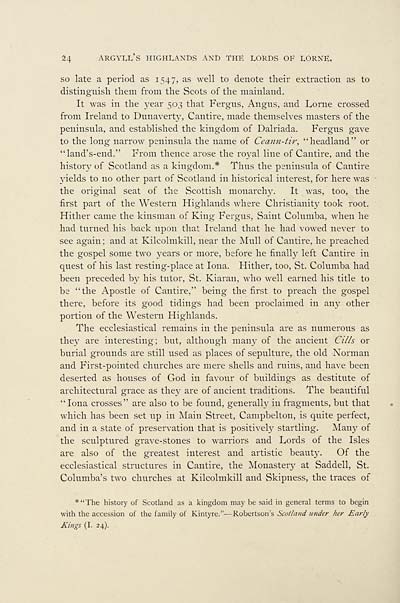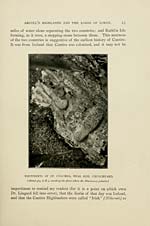Download files
Complete book:
Individual page:
Thumbnail gallery: Grid view | List view

24 ARGYLL S HIGHLANDS AND THE LORDS OF LORNE.
so late a period as 1547, as well to denote their extraction as to
distinguish them from the Scots of the mainland.
It was in the year 503 that Fergus, Angus, and Lome crossed
from Ireland to Dunaverty, Cantire, made themselves masters of the
peninsula, and established the kingdom of Dalriada. Fergus gave
to the long narrow peninsula the name of Ceann-tir, "headland" or
"land's-end." From thence arose the royal line of Cantire, and the
history of Scotland as a kingdom.* Thus the peninsula of Cantire
yields to no other part of Scotland in historical interest, for here was
the original seat of the Scottish monarchy. It was, too, the
first part of the Western Highlands where Christianity took root.
Hither came the kinsman of King Fergus, Saint Columba, when he
had turned his back upon that Ireland that he had vowed never to
see again ; and at Kilcolmkill, near the Mull of Cantire, he preached
the gospel some two years or more, before he finally left Cantire in
quest of his last resting-place at Iona. Hither, too, St. Columba had
been preceded by his tutor, St. Kiaran, who well earned his title to
be "the Apostle of Cantire," being the first to preach the gospel
there, before its good tidings had been proclaimed in any other
portion of the Western Highlands.
The ecclesiastical remains in the peninsula are as numerous as
they are interesting; but, although many of the ancient Cills or
burial grounds are still used as places of sepulture, the old Norman
and First-pointed churches are mere shells and ruins, and have been
deserted as houses of God in favour of buildings as destitute of
architectural grace as they are of ancient traditions. The beautiful
"Iona crosses" are also to be found, generally in fragments, but that
which has been set up in Main Street, Campbelton, is quite perfect,
and in a state of preservation that is positively startling. Many of
the sculptured grave-stones to warriors and Lords of the Isles
are also of the greatest interest and artistic beauty. Of the
ecclesiastical structures in Cantire, the Monastery at Saddell, St.
Columba's two churches at Kilcolmkill and Skipness, the traces of
*"The history of Scotland as a kingdom may be said in general terms to begin
with the accession of the family of Kintyre." — Robertson's Scotland tinder her Early
Kings (I. 24).
so late a period as 1547, as well to denote their extraction as to
distinguish them from the Scots of the mainland.
It was in the year 503 that Fergus, Angus, and Lome crossed
from Ireland to Dunaverty, Cantire, made themselves masters of the
peninsula, and established the kingdom of Dalriada. Fergus gave
to the long narrow peninsula the name of Ceann-tir, "headland" or
"land's-end." From thence arose the royal line of Cantire, and the
history of Scotland as a kingdom.* Thus the peninsula of Cantire
yields to no other part of Scotland in historical interest, for here was
the original seat of the Scottish monarchy. It was, too, the
first part of the Western Highlands where Christianity took root.
Hither came the kinsman of King Fergus, Saint Columba, when he
had turned his back upon that Ireland that he had vowed never to
see again ; and at Kilcolmkill, near the Mull of Cantire, he preached
the gospel some two years or more, before he finally left Cantire in
quest of his last resting-place at Iona. Hither, too, St. Columba had
been preceded by his tutor, St. Kiaran, who well earned his title to
be "the Apostle of Cantire," being the first to preach the gospel
there, before its good tidings had been proclaimed in any other
portion of the Western Highlands.
The ecclesiastical remains in the peninsula are as numerous as
they are interesting; but, although many of the ancient Cills or
burial grounds are still used as places of sepulture, the old Norman
and First-pointed churches are mere shells and ruins, and have been
deserted as houses of God in favour of buildings as destitute of
architectural grace as they are of ancient traditions. The beautiful
"Iona crosses" are also to be found, generally in fragments, but that
which has been set up in Main Street, Campbelton, is quite perfect,
and in a state of preservation that is positively startling. Many of
the sculptured grave-stones to warriors and Lords of the Isles
are also of the greatest interest and artistic beauty. Of the
ecclesiastical structures in Cantire, the Monastery at Saddell, St.
Columba's two churches at Kilcolmkill and Skipness, the traces of
*"The history of Scotland as a kingdom may be said in general terms to begin
with the accession of the family of Kintyre." — Robertson's Scotland tinder her Early
Kings (I. 24).
Set display mode to:
![]() Universal Viewer |
Universal Viewer | ![]() Mirador |
Large image | Transcription
Mirador |
Large image | Transcription
Images and transcriptions on this page, including medium image downloads, may be used under the Creative Commons Attribution 4.0 International Licence unless otherwise stated. ![]()
| Histories of Scottish families > Argyll's Highlands, or, MacCailein Mor and the Lords of Lorne > (44) Page 24 |
|---|
| Permanent URL | https://digital.nls.uk/95002390 |
|---|
| Description | A selection of almost 400 printed items relating to the history of Scottish families, mostly dating from the 19th and early 20th centuries. Includes memoirs, genealogies and clan histories, with a few produced by emigrant families. The earliest family history goes back to AD 916. |
|---|

